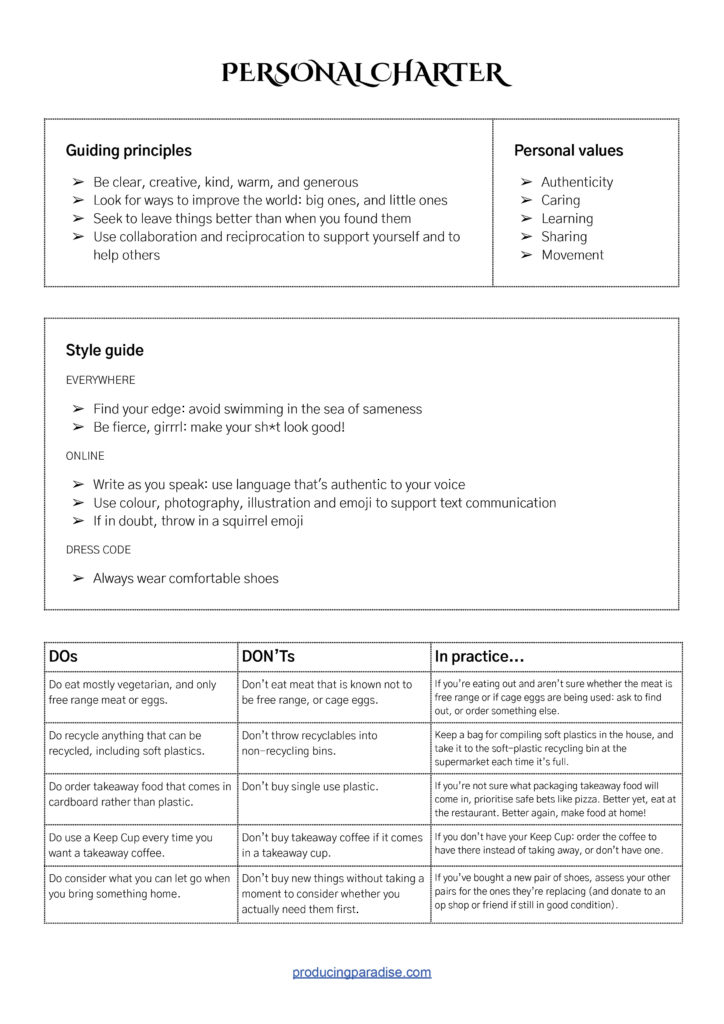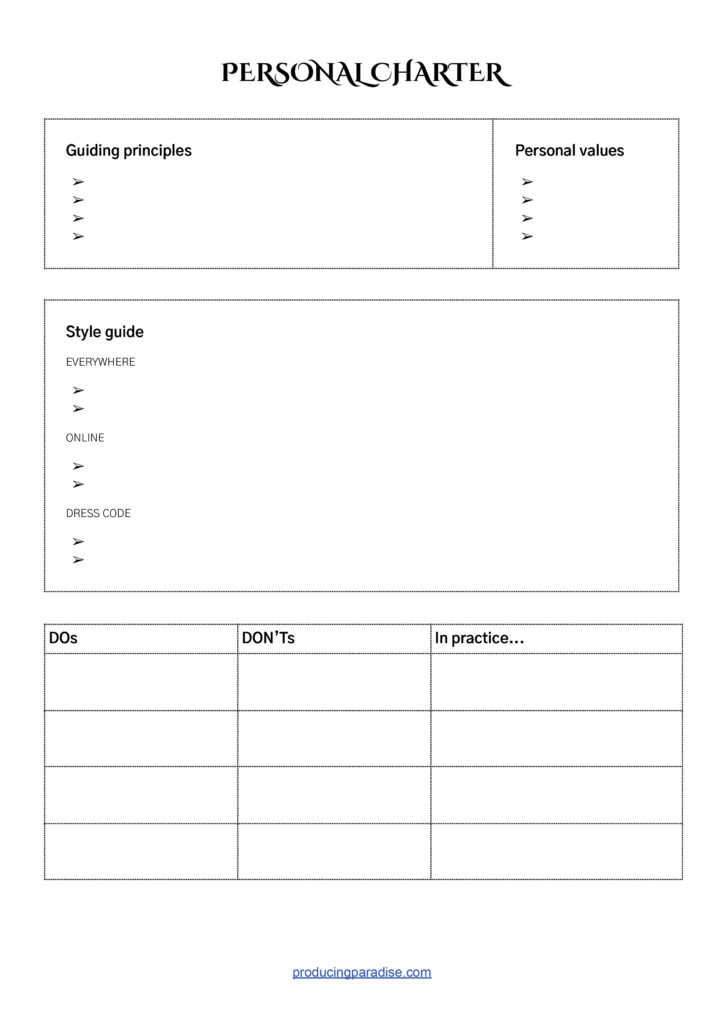Imagine if you were a company: what are your brand pillars? What’s on your personal charter? What are the non-negotiable rules your “employees” must follow? Here Jess ponders how thinking of herself as a company might make some decisions much easier, and shares a free template for creating your own personal charter.

A good company has a style guide, principles and rules, so its people don’t need to make choices about certain things. The choices have already been made, allowing employees to focus on their role.
So I’ve decided I should start running myself like a company. Hello, Jess Co™️!
Here’s where this started: I was looking at a Gucci bag my boyfriend had linked me to — it’s super cool and also super three thousand actual dollars (mmm, Gucci gear isn’t in my price range right now). My first idle thought was “I wonder if I could find a knock-off version online?”
For complete transparency, I have bought fake designer gear in the past. I rationalised it by telling myself I wasn’t “taking money away from Gucci” because I couldn’t afford the real deal anyway.
However, I’ve recently been thinking about my personal role in sustainable ecosystems, and how the majority of new fashion items don’t have a place there. I strive to buy as much as possible vintage or second hand, or at least prioritising companies with best practice environmental standards when buying new. The Good On You app has been a handy reference: it rates popular brands on their workforce, environmental and animal welfare practices.
If I was governed by the rules of Jess Co™️, it feels like the question “I wonder if I could find a knock-off version online?” would be answered “You could, but that wouldn’t be in line with your personal values” — and I wouldn’t entertain the search for a knock-off option, knowing instead to keep an eye on the markets and vintage stalls for something similar.
In other words: this wouldn’t be a decision.
So I’ve drafted myself a Personal Charter, something I can stick on my wall or in my phone as a reminder of what I stand for, and to help make at least some decisions easier.
The charter has four sections:
- The guiding principles act as a reminder for how I want to be
- The personal values are your deepest desires
- The style guide details how I want to appear, and what I want to present to the world (both online, and in person)
- The DOs and DON’Ts are specific, unbreakable requirements — a set of personal rules to live by
My personal charter
Here’s what I’ve got on my personal charter so far:
Guiding principles
- Be clear, creative, kind, warm, and generous
- Look for ways to improve the world: big ones, and little ones too
- Seek to leave things better than when you found them
- Use collaboration and reciprocation to support yourself and to help others
Personal values
Your personal values are your deepest desires: the things you value most. Mine are:
- Authenticity
- Caring
- Learning
- Sharing
- Movement
Don’t know what your values are? This explainer video (9min) might help!
Style guide
EVERYWHERE
- Find your edge: avoid swimming in the sea of sameness
- Be fierce, girrrl: make your sh*t look good!
ONLINE
- Write as you speak: use language that’s authentic to your voice 🗣️
- Use colour, photography, illustration and emoji to support text-based communication 🎨
- If in doubt, throw in a squirrel emoji 🐿️
DRESS CODE
- Always wear comfortable shoes 👟
DOs and DON’Ts
| DOs | DON’Ts | In practice… |
| Do eat mostly vegetarian, and only free range meat or eggs. | Don’t eat meat that is known not to be free range, or cage eggs. | If you’re eating out and aren’t sure whether the meat is free range or if cage eggs are being used: ask to find out, or order something else. |
| Do recycle anything that can be recycled, including soft plastics. | Don’t throw recyclables into non-recycling bins. | Keep a bag for compiling soft plastics in the house, and take it to the soft-plastic recycling bin at the supermarket each time it’s full. |
| Do order takeaway food that comes in cardboard rather than plastic. | Don’t buy single use plastic. | If you’re not sure what packaging takeaway food will come in, prioritise safe bets like pizza. Better yet, eat at the restaurant. Better again, make food at home! |
| Do use a Keep Cup every time you want a takeaway coffee. | Don’t buy takeaway coffee if it comes in a takeaway cup. | If you don’t have your Keep Cup: order the coffee to have there instead of taking away, or don’t have one. |
| Do consider what you can let go when you bring something home. | Don’t buy new things without taking a moment to consider whether you actually need them first. | If you’ve bought a new pair of shoes, assess your other pairs for the ones they’re replacing (and donate to an op shop or friend if still in good condition). |
I’ve turned mine into a sheet that I could print and stick on the fridge, and made a free template in case you’d like to give it a go for yourself — either make a copy of the Google Doc, or download the PDF 💁

What would you put on your personal charter?




